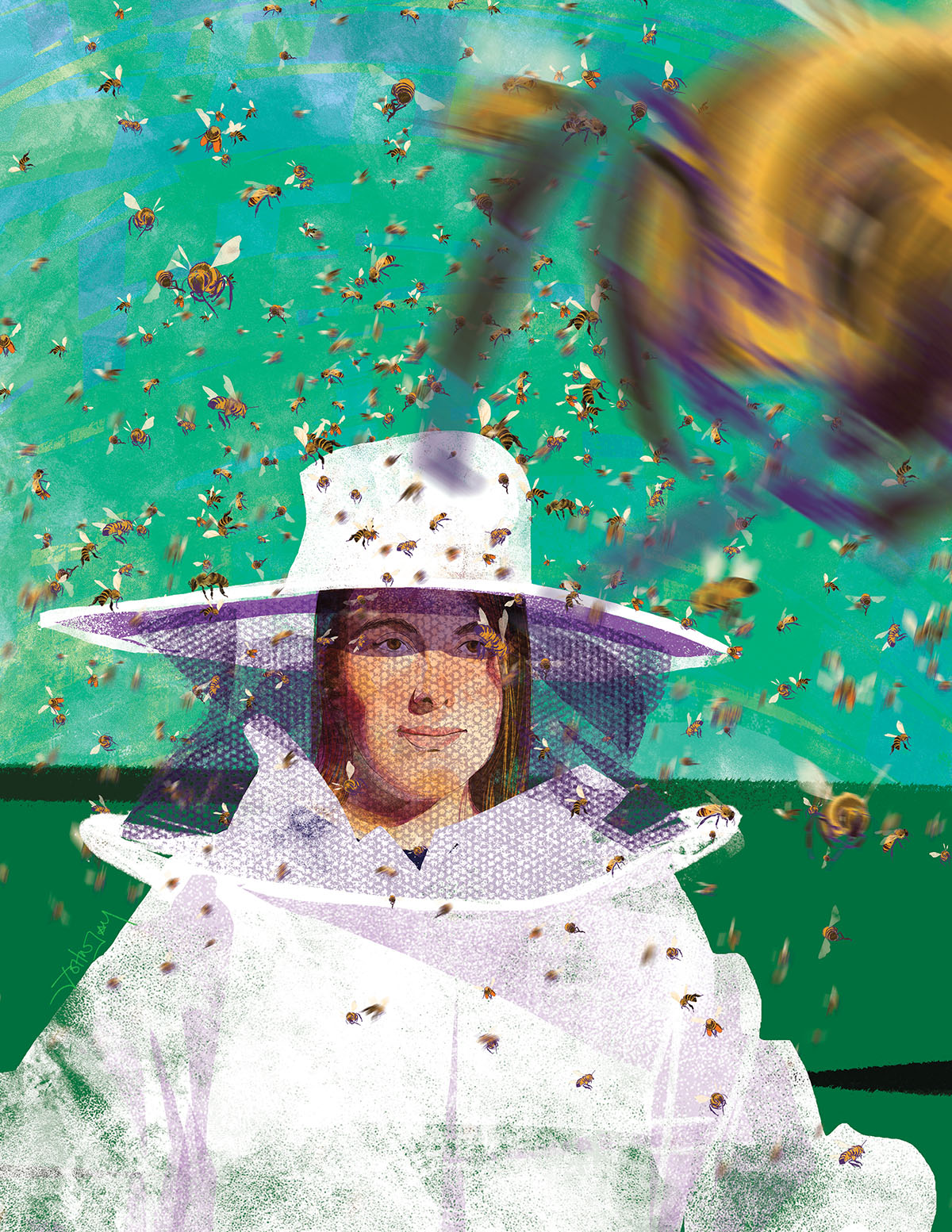
I keep my bees in the city. The hives are in a nature preserve in South Austin, just east of Interstate 35, where the neighborhood is gentrifying like so many other Austin neighborhoods. New modern houses, half-built, tower over the single-story homes from an earlier generation. The apiary is next to one of these construction sites, down a narrow and pitted dirt road. For months I’ve watched the house being built—granite slabs stacked and leveled for the patio, iron girders outlining the empty shapes of windows. The xeriscape garden is mostly dust. Across the street, the vacant lot is full of firewheel and waist-high prickly poppies.
The bees aren’t easy to find without knowing their exact location. I follow the dirt path down a long hill, past a screen of trees, and emerge into a field where the landscape is dotted with a five-lobe purple flower whose name I don’t know. In the grass, about a dozen white beehives sit on a row of cinderblocks. Honeybees go in and out, visiting the flowers or the quiet creek, or, on the hottest days, hang in clusters like elderberries on the outside of the hive, waiting for a breath of cool air. It’s as if I’ve stumbled into a hidden world inside the city—from the street above, passersby would never suspect the bees were there.
I began to learn beekeeping in 2020, six months into the COVID-19 pandemic. Nearly everyone who works for Two Hives Honey, the Austin company that now employs me, had some previous career. I had been a bookseller at Malvern Books, an independent Austin store specializing in experimental literature, and I had sent my first novel out on submission two weeks before Austin temporarily shut down nonessential businesses. In the months that followed, the bookstore drastically cut its hours and lost much of its staff, including me. My novel waited in limbo.
My personal problems felt small compared to the scale of what was happening in the world. I filled out job applications from my apartment bedroom, and in late summer I enrolled in a beekeeping apprenticeship program run by Two Hives. I didn’t initially think of it as a work opportunity. For a few years before the pandemic, I’d entertained beekeeping as a fantasy life I might have. Some day in the future, I thought, perhaps when I was old, I’d learn to keep bees. Unemployed and in a national emergency, some day in the future felt like a very thin fiction. I joked that I was trying to acquire a useful skill for the end of the world.
I joined other beekeeping students on the lawn in front of the apiary for the first class, each of us wearing a cloth or surgical mask. We went over honeybee biology and development: their five eyes, the spiracles through which they breathe, their progression from egg to larva to pupa to adult bee. In the afternoon, we put on bee suits and moved through the hot apiaries, opening hives.
At first glance, the inside of a beehive is chaos. Each hive box contains removable frames, which a beekeeper can pull out to inspect in order to verify the health of the hive. But bees build to their own designs, constructing bridges of wax between adjacent frames or gluing frames together with propolis—an anti-microbial paste made from plant resin that forms part of the immune defense of a colony. In the darkness of the hive, bees build their combs with just enough space between them to let two bees on adjacent frames pass each other. Looking down on a healthy open hive, I had the impression that every inch of space was packed with honeybees, somehow still moving purposefully despite the crowd. I pulled a frame loose and some took flight, while others made hanging festoons at the bottom of the frame. The hum of the hive vibrated upward from the open box. For the first time since the pandemic started, I felt like I was fully present, as if some invisible screen separating me from the world had been removed.
I lived in a second-story apartment whose only outdoor space was a small balcony. I knew almost no one in Austin who had a yard. Where I would keep bees, if I had my own, was a mystery. But after that first class, I knew I was going to find a way.
Even within Austin, there are places where bees thrive, and places where they don’t. To the city’s west, the Balcones Fault runs roughly parallel with MoPac, creating the springs that feed the Barton Creek Greenbelt. Over millions of years, the soil of the western side has eroded, baring limestone and dolomite. The forage there is sparse, but honeybees are adaptable. The honey harvested from those neighborhoods is so dark as to be nearly black, and it smells like burnt sugar. It’s the color and flavor of nectar from the chapote tree—one of the few flowering trees that flourishes in the Hill Country. The eastern side of the fault zone is lower, and its more fertile soil supports lush blooms of spring wildflowers, summer mesquite, and fields of aster and goldenrod in the fall.
During the six months of my apprenticeship, I visited the 300 or so hives managed by Two Hives in apiaries across Austin. I learned what they required at different times of the year. At the end of the program, the owner of the apiary sent a group email that mentioned she was hiring. When I told her I’d like to apply, she said, “I hoped you’d say that.”
Before I put on a bee suit, during the first months of the pandemic, I played video games. The game I most lost myself in was Red Dead Redemption 2. Its story is simple: You are an outlaw dying of tuberculosis just as the Old West is ending. Like Blood Meridian’s posthole digger, eating up the landscape with teeth made of barbed wire, train tracks and industry are taming the wild landscape. Soon, even if you weren’t doomed by disease, there will be no place left for you. I was drawn in not by the generic Western plot—gunslinger rides into trouble and shoots his way out of it—but by the obsessive detail with which the natural world was rendered inside the game.
Without leaving my dark, climate-controlled living room, I rode out into what looked like the Hill Country, with its squat juniper trees and grass turning to straw in the summer heat. The riverbed a half day’s ride away on horseback had banks of the same crumbling limestone that Austin creeks have. Birds drank from it—a dozen species. If I waited and watched, the milk-blue light of morning would turn gold, and then the sun would set.
I spent a lot of time not playing the game, per se, but instead riding the trails inside of it, camping in the desert, trying to lose myself in the imaginary world that more than 2,000 artists, designers, writers, programmers, and others had created over countless hours. Despite the world’s smallness, the game was designed with such loving attention that it feels like it might go on privately without the player’s intervention. If I aim my rifle and shoot down the hawk that comes to prey on the birds at my stream, I might feel a momentary pang, forgetting that its death is as imaginary as its life. Whether or not I shoot, it will stop existing the moment I stop looking at it.
Gamers can camp out in the Hill Country and watch birds for as long as they like. But for all the intricacy of the created world, there are only a few ways the game can imagine players interacting with it.
No matter how immersive the experience of looking at a screen becomes, it’s not real life. I can almost forget my body while playing a video game, but in an apiary, my body aches from lifting heavy boxes full of honey, and my thirst rises until I feel like a piece of driftwood, soaked in the salt of my own perspiration. The air smells like woodsmoke, sweet beeswax, and human sweat. But still, sometimes an urge rises, when I’m in the middle of an open hive, surrounded by flying bees, with the thin screen of the beekeeping veil a hot layer between myself and them. I want to pin the moment in place, pull it out of the stream of time, and turn it into something I can keep.
On Instagram and TikTok, there are dozens of accounts showing beekeepers at work. Some people are perfectly coiffed and made up; others are realistically sweaty, working in full suits or light veils or in no protective gear at all. Their videos appear to reflect real beekeeping, provided you haven’t done a lot of this kind of work in real life. But after a while, the content starts to look mechanically produced: the same close-up shots of bees crawling over honeycomb or smiling beekeepers holding up frames pulled from the hive. Something is lost in those pictures—instead of opening up the wonder and specificity of the world, they flatten it into one more image to scroll past unthinkingly.
And yet I, too, have this urge to whip my phone out in the apiary and freeze whatever I’m looking at on an endless video loop.
Not long ago, the time a beekeeper spent in the apiary would have consisted of quiet moments. Now I drive between beeyards playing music through a streaming service and log my break at a taco truck on the app that tracks my hours. Sometimes I get a cellphone call when I’m in my bee suit, a hive open in front of me, and I answer it on speaker: “I’m in bees. Can I call you back?” I have an app on my phone called iNaturalist where I upload photos of wildflowers and insects I don’t recognize. It matches them to its online pool of images and provides suggestions as to what they might be: bindweed, clockweed, fumitory, marsh elder.
It’s not always hostile, this penetration of the virtual into the natural world. When I misidentify a plant on the app, a neighbor helps me out with a detailed guide to distinguishing the two species I’ve confused. How pointed are the leaves? Are they covered in velvet-fine fuzz, or coarser hairs? Do they have a smell if you rub them between your fingers? One flower is native to Texas, the other an invasive species introduced by human thoughtlessness.
In both natural and virtual spaces, we inhabit a world that is shaped by human intervention. Sometimes it is deliberate—a digital rendering of wind blowing through grass, a game interface, a well-planned city, a forest that has been tended so fire doesn’t catch easily in its understory. But our carelessness and inattention also shape the world. We carry seeds to places where they weren’t meant to grow. The summers grow hotter
—and harsher.
I keep returning to the birds in Red Dead Redemption, to the hunting rifle that I carry with me into the virtual wilderness. Is it a deliberate choice to make killing things the player’s main method of interacting with the world? Perhaps I’m meant to feel complicit in its destruction. Or perhaps the game works that way because some designer’s imagination stopped there.
Honeybees are also largely considered an introduced species, a change that humans have made to the landscape. The first European settlers in America carried honeybees across the Atlantic in woven straw hives. From their apiaries, swarms of bees escaped and moved westward along the same route as European expansion, finding new hive sites first in blasted trees and sheltered caves, then in the siding of city houses, old sheds, owl boxes, water meters, and thousands of other hollow places.
Last summer was so dry the goldenrod died in fields all over the city. Deep cracks spiderwebbed the ground at our main apiary, as if the grass was becoming desert. The weather was punishingly hot. The air conditioning in the ambulance we’d retrofitted into a mobile honey harvesting room went out, and by midday, the heat inside was so oppressive the beeswax was melting off the frames of honeycomb as we uncapped them. We waited days for a repair. In the meantime, I arrived at the apiary at daybreak and worked in the cool hours, cutting the wax caps off frames of honey and spinning them out in the extractor, sticky to the elbow.
It was the worst year for Texas wildfires in a decade. The parched landscape became a tinderbox. One week a house a few doors down from our main apiary burned down. The next, three fires sprang up on the nearby farm-to-market road. One day I left the apiary and drove into downtown with the squat shape of the Tesla factory at my left hand and a column of smoke at my right, always just visible from the corner of my eye.
One fire burned a client’s apiary—someone I’d been giving beekeeping lessons to. It caught deep in the mulch under his beehives, and for a week it flared up intermittently, even after the fire department was called to extinguish it. Bees know how to wait out a fire. They retreat deep into a hive, away from the heat and smoke. They gorge on honey in case they need to abandon their home and find shelter somewhere new.
The beekeeper’s instinct, after a fire, is to open the hives and see whether the bees survived or fled. But a disturbance following a fire may make the bees abandon the hive. The best thing you can do is to leave them alone. After the fire, we waited a month before opening the hives. The white boxes were scorched black on one side, where the wind had thrown the flames up against the hive. On the outermost frames of comb, the wax had melted into strange shapes. The bees inside were alive. They were making honey.
At first, all seemed right. Then, in the months after the fire, one hive killed its queen. This happens, sometimes, when a hive is ill or when it undergoes a shock, as if the worker bees blame the queen for what’s happened to them. The bees were still bringing in nectar, but without a queen they had no brood, no developing bees to replace the current generation of workers once they died. We ordered a new queen bee from a breeder, installed her in the hive as a replacement, and the hive killed her. They killed the next queen as well. Their population dwindled. Each time we opened the hive, they were angrier, spilling out to try and sting us through our protective gear. On either side of the dying hive, within a few paces, the other bees were thriving in their burned boxes.
In January, I was up in the loft of the Two Hives barn, organizing beekeeping gear, when I heard the buzzing. It traveled up the field, past the open loft door and into the parking lot. When I descended the stairs, one of the other beekeepers was waiting there in a cloud of bees circling together for no apparent reason. They looked like a swarm—a group of bees that leaves the hive, along with their queen, to establish a new colony elsewhere. But January, however mild, is not the right time of year for a swarm. There would not be enough nectar to sustain them for the months to come.
We couldn’t figure out what they were doing. A bee pinged off my face as we talked, then corrected her course. I watched as the cloud of bees drew together, moving across the meadow, condensing around the skeletal, bare branches of a kidneywood tree. I followed them, without my veil, feeling the occasional touch of wings against my arms and face. Swarming bees are usually gentle. Without a home, they have nothing to defend.
It was a swarm—despite the time of year, despite the brutal cold snap just a week prior. The henbit was blooming in our meadow. The bees were clustering on the kidneywood tree, hanging like a plum from a branch six inches above the ground. I got down on my hands and knees to look at them. The cluster was the size of my clenched fist. It was too small to survive alone.
The next day, we caught the swarm in a Tupperware and teased the cluster of bees apart to find the queen. We’d do what we could to help them survive.
I watched them for a little longer. The swarm was like an organ of a living body—the bees inside moved together. I don’t know what made them leave the hive at this barren time of year, and the inspection I did the next day wouldn’t solve the mystery. But that day, at the golden hour, it was enough to watch without understanding. I got out my phone, took aim, and started filming.








